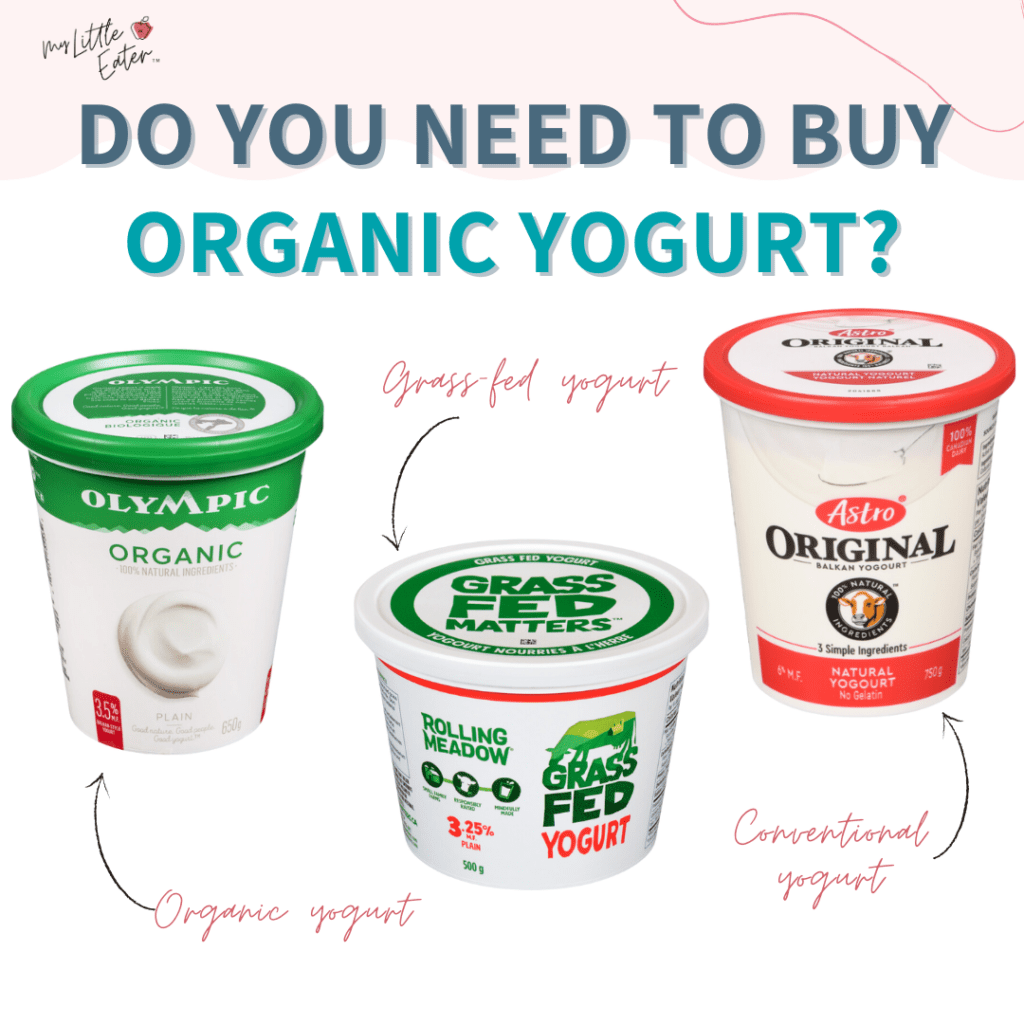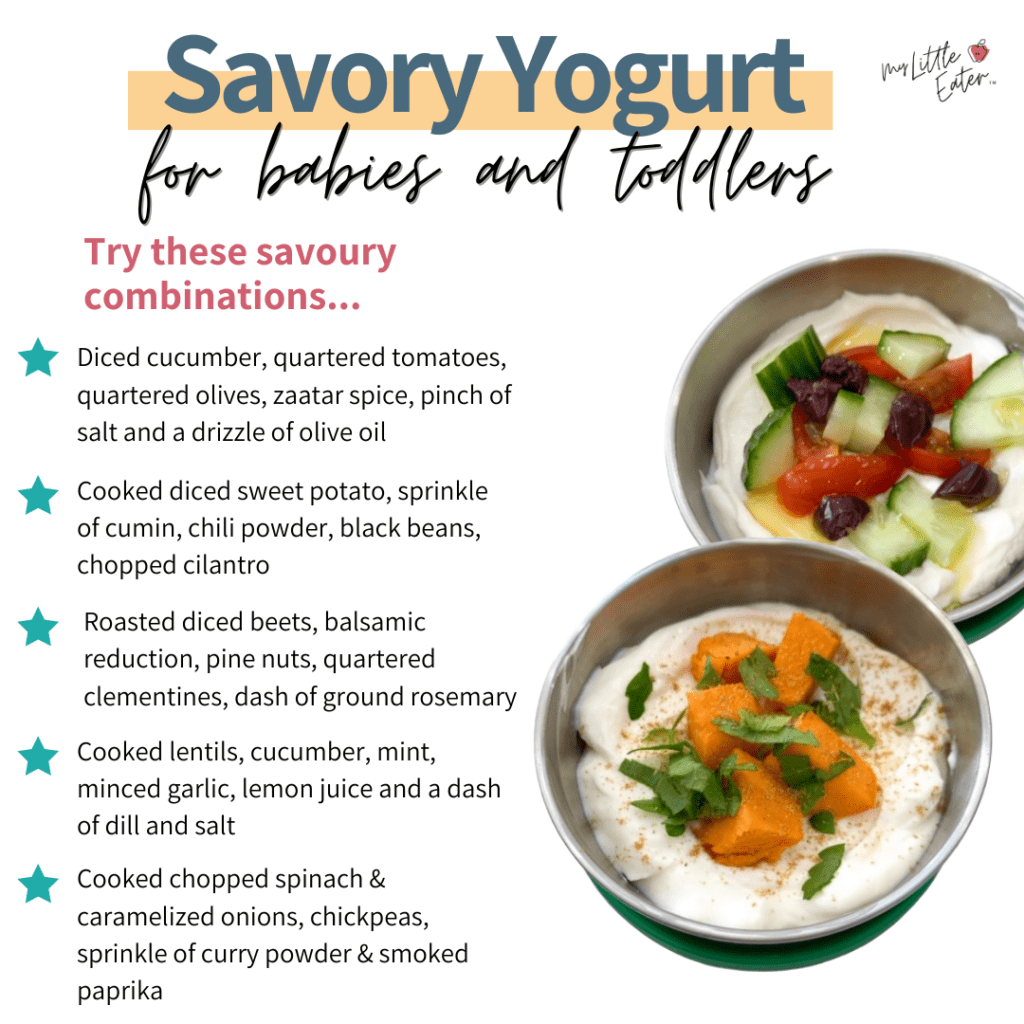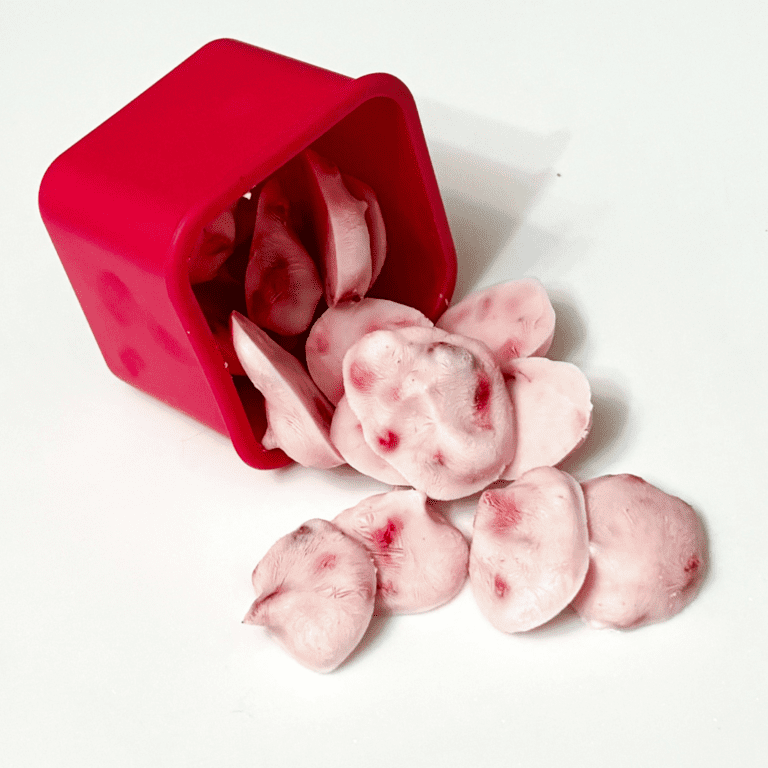This post may contain affiliate links, please see our disclosure policy for more details.
With the diversity in the yogurt aisle, it’s safe to say that choosing one can be downright overwhelming! And with so many flavors, fat percentages, and brand names, it can seem impossible to pick the best one!
It’s first important to find the right yogurt that meets the nutritional needs of your baby’s rapid development during this crucial period of growth. Nutritional aspects that matter the most are protein and fat, plus nutrients like vitamin D, calcium, and potassium.
Let’s guide you through what qualities the best yogurts have and what nutritional aspects to look for, plus give you some of our top recommended brands to narrow down your search so that you can be confident that you’re making the right choice for your baby!
If you want to learn how to feed your baby healthily and how to serve foods safely from 6 months+, see our Baby Led Feeding online course! With lessons on how to set up mealtimes, what foods to introduce, allergy introduction, and even an extensive video library showing how to serve foods based on the phases of our signature Texture Timeline™, you’ll get everything you need for starting solids in this one course (and have access to it for life!).

Table of Contents
Can babies eat yogurt?
Absolutely!
Yogurt can be introduced as early as around 6 months of age, or when your baby is showing all of the developmental milestones for starting solids.
Yogurt is a high-calorie and high-fat food, which is one of the three food types we recommend including when creating a balanced baby plate. Cow’s milk yogurt is also a top allergen, and research shows that introducing top allergens early and often is best for preventing food allergies.

Currently, the recommendation is not to include cow’s milk in your baby’s diet as a beverage, but that doesn’t include products that contain cow’s milk as an ingredient – like yogurt!
PS – the recommendation to avoid cow’s milk has nothing to do with cow’s milk itself and more to do with the potential that it will replace calories they’re getting from breastmilk or formula. Both of those are more nutritionally adequate during this age and are better on their digestive system.
The benefits of yogurt for babies

It’s a good way to introduce allergens
As mentioned, cow’s milk products are considered one of the top 10 allergens recognized in Canada and the United States. With new research emerging recommending not to delay the introduction of top allergens, yogurt can be a great food to start with, and could potentially decrease the risk of your child developing a cow’s milk allergy.
Plain whole milk yogurt is also a good way to introduce other allergenic foods, like peanuts or tree nuts. Once you’ve ruled dairy out as a food allergy, it’s really easy to mix nut butter or powdered nuts into plain yogurt for babies to eat and rule out more allergies.
Be sure to always rule out allergies individually and follow proper allergen introduction protocols.

It’s packed with nutrition
Yogurt is also a great source of protein and healthy fat which are important for rapid growth during the first year of life. Ensuring they’re eating good sources of protein can help them continue on the proper growth trajectory. Fat content is super important for babies under 24 months old. An infant’s brain is growing rapidly and high fat content is essential to make sure proper brain and nervous system development can occur.
Although yogurt doesn’t contain as many probiotics as other fermented foods like kefir, many brands still have live cultures that are beneficial. Probiotics promote good bacteria growth in the gut which can help your baby with diarrhea or constipation, and are beneficial for general gut health and immunity.
The best type of yogurt for babies (and toddlers)

When deciding on the best type of yogurt for your baby, it’s always recommended to choose full-fat, plain yogurt with no added sugars or artificial sweeteners, and with the fewest ingredients possible.
Generally, yogurt that is high-fat ranges from 4-10% milk fat making it a more calorie-dense option. Since babies have small stomachs, they really can’t eat that much food in one sitting. Having a full-fat (or whole milk) yogurt can be a great way to get in enough calories during a meal, plus it contributes to the much-needed fat content required for their diet, as mentioned above.
We recommend looking for a milk yogurt with minimal ingredients, ideally one with whole milk, cream, and live active bacteria cultures. Some contain gelatin, and while there’s nothing unhealthy about it (unless you’re looking for a kosher option), it’s used as an additive to compensate for missing textural qualities found in processed yogurt. Real yogurt doesn’t need any gelatin!
Do you need to buy organic or grass-fed yogurt for babies?

This choice is totally up to you!
If there’s room in your budget, opt for a grass-fed option due to the increase in CLA and omega-3 fatty acids. However, it’s certainly not something for anyone to stress over! There’s nothing wrong with choosing to buy conventional yogurt. It still has many benefits and so this really comes down to what feels right for your family.
Organic is yet another option to consider. This is something that we’re more concerned about for dairy products made in the US because organic ensures that the milk used is from cows that haven’t been treated with antibiotics or growth hormones. In Canada, this isn’t an issue because it’s a standard requirement for all Canadian cows, so organic may only be a preference if you’re more concerned about environmental practices.
Learn more about when we recommend opting for organic foods for babies and toddlers.
Greek yogurt, skyr, or regular milk yogurt?

As if navigating brands and nutritional content weren’t enough to make your head spin, there are also different types of yogurt to wrap your head around…like Greek and skyr.
Greek yogurt is higher in protein and generally provides more fat than traditional yogurt. Because it’s considered a strained yogurt, it has a much thicker texture in comparison to traditional yogurt. This can actually be beneficial in baby led feeding because it’s easier for babies to self-feed with if they choose to.
Skyr yogurt is often compared to Greek yogurt because of its high protein content and thicker texture but it’s traditionally an Icelandic-style yogurt and is made using different milk cultures than Greek yogurt. It’s made using a substance called rennet which makes it much more like a cheese than a yogurt. This is why it’s more creamy, thick, and less sour.

Skyr yogurt can be a good option for your baby because, like Greek yogurt, it has high amounts of protein, but, because it’s made with skim milk vs whole milk, it doesn’t contain any fat (or very little fat), which means you’d have to look to other foods to fulfill this need.
One thing to note is that in the beginning when introducing Greek or Skyr yogurt to your baby, it’s helpful to start with smaller amounts (about 1 tbsp) and gradually work your way up from there. Because it’s higher in protein, it may be harder on their digestive system all at once, so gradually easing into it is recommended.
MLE-approved yogurt brands
Below are some of the brands of yogurt we recommend that can be found in Canada and the United States. All of these yogurts are plain, high in milk fat (ranging from 4-11%), and have limited ingredients. These brands are easy to research online if you want to further explore the other nutritional facts, like the best yogurt for calcium and vitamin D content.

We’ve also included below some good choices for babies that have lactose intolerance or are avoiding dairy for other reasons.
Astro Balkan is a great lactose-free yogurt because it still has one of the best protein and fat contents compared to the others. Unfortunately, it’s difficult to find a lactose-free, whole-milk yogurt with at least 4% milk fat. If you’re struggling to find the Astro yogurt we recommend, feel free to give one of the dairy-free options a try instead!
Keep in mind that some dairy-free versions are made with bases of cashews or soy, which are also top allergens, and these products should be avoided if your baby has a sensitivity.
Best lactose-free options:
- Astro Balkan Lactose Free 6% (1/3 cup serving) – Calories: 58, Protein: 2.7g, Fat: 4.4g, Sugar: 2.2g
Best dairy-free options:
- Forager Cashewgurt (cashew based) (150 g) – 110 kcal, Protein: 3g, Fat: 7g, Sugar: 1g
- Liberte Dairy free (coconut yogurt) (1/3 cup serving) – Calories: 53, Protein: 0.4g, Fat: 4g, Sugar: 0.4g
What about the sugar in yogurt for babies?

As long as the yogurt you’re choosing is plain and unsweetened, the sugar you see on the label is nothing to worry about!
That’s because cow’s milk yogurt has a naturally occurring sugar called lactose – the same natural sugar found in breastmilk!
Typically, for every 100g of plain unsweetened yogurt there is around 4.5g of naturally occurring lactose, which is what makes up the sugar content listed on the nutrition label. However, the higher the milk fat percentage of the yogurt, the more lactose will naturally be present. That’s why you may see more sugar on the nutrition label of plain yogurt with 10% milk fat compared to 4% milk fat.

As long as the package says plain and unsweetened, all the sugar noted on the label will be lactose and therefore doesn’t need to be avoided. Natural sweeteners like stevia, agave syrup, honey, fruit syrup, fruit concentrate, and fruit puree are still considered added sugars. When you’re looking into different brands, make sure these aren’t included on the ingredients label.
Avoid sweetened or flavored yogurts

We recommend completely avoiding any sweetened yogurts for babies and toddlers. Flavored yogurts are loaded with added sugar, which we want to avoid as much as possible until around 2 years of age from both a health perspective, and to not train them to be used to only sweet things. Once they taste that delicious sugar-sweetened yogurt…they’re less likely to go back!
Trust us…we’ve seen many babies and toddlers refuse to go back to unsweetened, plain yogurt once they’ve had a taste of the sweeter versions (my kids included!).
Parents often see their babies make funny faces when they serve yogurt the first few times. This leads them to think that they don’t like plain yogurt (and maybe won’t ever like it that way). Of course, that pushes parents to rush in and sweeten it up so that it’s more palatable.

Instead, take advantage of the 6-9 month window where their palate can be primed and trained to accept lots of new flavors and where they aren’t asking for the sugary version of everything! Start with unsweetened yogurt and continue to offer it this way, giving them the time they need to get used to the tart taste. You may be surprised to see that they’ll begin to enjoy it and usually we see very few complaints after many exposures.
Should babies have baby or kid branded yogurt?
We know you’ve seen them…the Paw Patrol yogurt cups or drinks, the ever-popular yogurt tubes, and of course we can’t forget the cute little mini-yogurt cups for kids.
They look perfect for your baby or toddler, right? After all, a little novelty can go a long way in making a little eater try something new!
Unfortunately, these brands know that if they put a Paw Patrol puppy, Pokemon character, or Peppa Pig on your child’s yogurt they’re more likely to eat it…which means you’re more likely to buy it again! Essentially – really good marketing 🙂

However, at best, these yogurts pack the same nutritional value as other “adult” yogurts, and at worst, they are full of added sugars because they’re almost always flavored yogurts (and they’re typically lower-fat options too).
While we’re all for novelty, we don’t generally recommend these options for your baby or toddler because they are usually more expensive than bulk “regular” yogurt options (small packaging for a higher cost), and they don’t always meet the nutritional criteria we look for.
Instead, add novelty in other ways (for toddlers especially)! Try these options below, most will not work for babies just starting solids but are good for picky eaters and toddlers that are learning to like the taste of plain, whole milk yogurt.
- Serve yogurt in a non-traditional dish like a silicone muffin liner or baby-sized open cup
- Offer a fun spoon to scoop it with, like a measuring spoon or Num-Num Gootensil (toddlers love trying these out especially if they have a baby sibling that uses them often!)
- Start with yogurt as a dip and cut fruits and veggies into fun shapes using these food cutters and offer fun food picks for dipping
- Or, keep it simple and serve their yogurt in a bowl with their favorite character on it and offer a matching spoon too!
Natural ways to flavor plain yogurt

Even though we don’t recommend purchasing flavored yogurt, that doesn’t mean you can’t flavor it at home where you have control over the ingredients as a way to introduce more variety. We’re always on-board with including more variety in the solid foods that you offer your baby, and there are lots of ways to naturally sweeten yogurt yourself with no artificial or processed sugars!
Sweetened yogurt ideas
- Adding a dash of cinnamon and mixing it in (although it’s not sugar, cinnamon can impart a slightly sweet taste in small amounts!)
- Add mashed or pureed fruit – banana, strawberry, blueberry, and raspberry are all great examples (you could even use your favorite store-bought baby food for this!)
- Mix in ½ tbsp – 1 tbsp of unsweetened applesauce
- Mix in ½ tbsp – 1 tbsp of natural peanut butter
For children who may require higher-calorie foods, peanut butter and coconut oil are great options to increase calories in their diet.
Savory yogurt ideas

Another benefit to using plain yogurt is that it makes for a diverse ingredient that can be used, not only as a sweet food option but also as a savory! It’s a simple way to introduce new flavors – including veggies! This works especially well if your baby or toddler already LOVES yogurt. Research shows that pairing liked foods with new foods increases acceptance!
Here are some of our favorite mix-ins to try:
- Sprinkled chia seeds, hemp hearts, or flaxseeds
- Diced raw or cooked vegetables like cucumbers, cooked sweet potato, cooked beets, raw radish slices, shredded zucchini, avocado…you name it!
- Pureed veggies like butternut squash or pumpkin puree
- Protein toppers like pureed black beans, chickpeas, or lentils
- Ground seeds like pumpkin or sunflower seeds (whole seeds are okay for 4+ years)

Plain yogurt is also a healthier alternative to mayo, sour cream, salad dressing, and even alfredo sauce for pasta.
Here are some ideas for using yogurt in unexpected ways:
- Try plain, Greek yogurt in place of sour cream on tacos, burritos, on top of chili, and even as a way to moisten, and add some interest, on top of pancakes.
- Serve yogurt in place of mayo in an egg salad. Spread a bit of that on a piece of toast, cut it into strips, and you have a great finger food option for baby, if doing baby led weaning.
- Make fun and tasty vegetable dips, and if you’ve previously completed my Feeding Toddlers online course, you’ll know all about how dips can add novelty and fun to mealtime!
- Incorporate yogurt into baked goods like muffins, as a replacement for butter or oil.
- Serve your toddler or baby yogurt as part of a smoothie or smoothie bowl.
- Try the frozen yogurt bites recipe at the end of this blog!
How to offer yogurt to your baby

Fair warning – this could get messy!
If you’re following a baby led feeding method, feel free to let your baby explore the texture of the yogurt with their hands and self-feed. If your baby doesn’t want to use their fingers, offer them a Num Num gootensil which is a great dipper utensil that can be used as early as 6 months. It allows the yogurt to easily grip onto the utensil, which makes it easy for baby to be able to get it in their mouth without it falling off, like it may with a typical spoon!
Serving Greek yogurt to your self-feeding baby is more helpful because of its thick texture, making it easier for them to pick up and helps it stay put on a utensil. And by all means, if your baby does not want to self-feed feel free to help them spoon-feed!

You can also use this opportunity to easily offer foods that are typically difficult for babies to self-feed on. Use the yogurt as a vehicle to mix these foods into so baby can more easily get them to their mouth without dropping them.
Some foods you can try this with are: grains, quinoa, rice, or even ground beef. Since meat can be a bit dry sometimes for babies, coating it lightly in yogurt can help moisten up the meat so that they can more easily and safely chew it.
If you want to learn how to safely serve all foods to your baby, using purees or finger foods, and get step-by-step guidance in how to gradually advance your baby onto more difficult textures, check out our Baby Led Feeding online course!
It has everything you need to start solids with your baby, from info on gagging and choking to nutritional considerations for babies and an easy-to-search food video library, plus so much more! Get started today and have access for life with ongoing support from the My Little Eater team for any questions or concerns along the way.

Baby yogurt melts
We have lots of recipes using yogurt inside our 60 Day Baby Led Feeding Meal Plan, but yogurt melts are something we get asked about a lot as they can be a nutritious and easy snack to keep on hand that babies and toddlers typically love. They also work great for practicing pincer grasp once baby hits about 8 months old!
We haven’t found a store-bought option that contains dairy that we truly love yet (most are very processed), so if making your own at home is not your idea of a fun time, we highly recommend Amara Smoothie Melts! They’re dairy-free but are made with coconut milk so they still offer a good fat profile for babies. Use code LITTLEEATER for 15% off your purchase!

Vanilla Raspberry Frozen Yogurt Bites
Equipment
- 1 baking sheet
- 1 baking sheet liner (or parchment paper)
- 1 mixing bowl (small)
- 1 piping bag and tip
Ingredients
- ½ cup full-fat yogurt (plain)
- 1 tbsp raspberries
- ⅛ - ¼ tsp vanilla extract
Instructions
- Put all ingredients into the mixing bowl. Smash the raspberries with a fork and thoroughly mix everything together.
- Scoop the mixture into the piping bag and line a baking sheet with a silicone liner or parchment paper.
- Pipe out small circular shapes (ie. drops) of the yogurt mixture across the entire baking sheet.
- Place baking sheet in the freezer and freeze for at least 5 hours, or overnight.
Notes
- We recommend fresh raspberries as they'll be easier to mash and combine with the yogurt.
- Choose how much vanilla to add based on your family's taste preferences. If you prefer a more subtle flavor, we recommend halving the amount of vanilla to 1/8 tsp.
- If you don't have a piping bag and tip, place the mixture into a ziploc bag, squeeze the air out, and cut the tip off of one corner. Works just as well for this!
- Don't worry about making the yogurt drops perfect or all the same shape, your kids won't care and they'll all freeze overnight even if some are a bit bigger. We recommend about the size of a nickel as a guide.
- These melt fairly quickly so they're a treat best enjoyed at home to limit mess!
- Substitution: Feel free to substitute cow's milk yogurt with your non-dairy yogurt of choice. We haven't tested them but it should work just as well!
- Apple Cinnamon - mix 1/8 tsp of cinnamon and 1 tbsp of unsweetened applesauce with 1/2 cup of full-fat, plain yogurt.
- Peanut Butter and Banana - mix 1/2 tsp ground peanuts (or almond, cashew, etc.) and 1 tbsp of mashed banana with 1/2 cup of full-fat, plain yogurt.
- Savory beet and dill - mix 1/8 tsp of dill and 1 tbsp of cooked, blended beets with 1/2 cup of full-fat, plain yogurt.
Was this helpful? Pin it to save for later!


Edwena Kennedy, RD
Founder and lead Registered Pediatric Dietitian at My Little Eater Inc., creator of The Texture Timeline™, and mom of two picky-turned-adventurous eaters.

Edwena Kennedy, RD
Founder and lead Registered Pediatric Dietitian at My Little Eater Inc., creator of The Texture Timeline™, and mom of two picky-turned-adventurous eaters.









